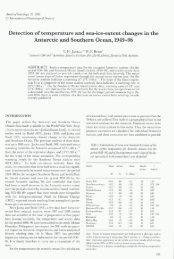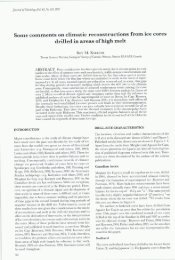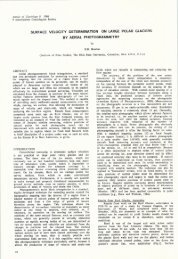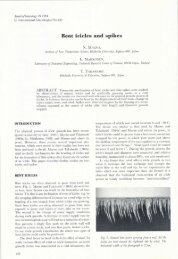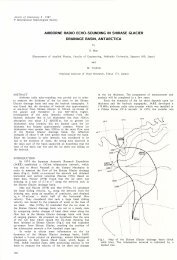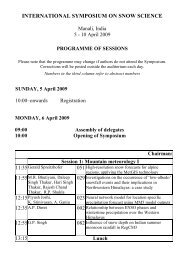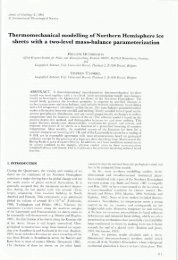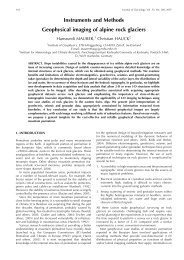143-156 - International Glaciological Society
143-156 - International Glaciological Society
143-156 - International Glaciological Society
You also want an ePaper? Increase the reach of your titles
YUMPU automatically turns print PDFs into web optimized ePapers that Google loves.
SIMULATED GLACIER SLIDING<br />
/'<br />
Upstream<br />
PreS5urf' gouge<br />
Oowns!rf'om<br />
"', ,<br />
'-..<br />
COV;f<br />
Fig. 4. Diagram showillg the sensors attached to each obstacle.<br />
Consequences of this are: (I) a large torque is measured even when both the confining<br />
pressure and the pressure in the cavities are at atmospheric pressure; (2) at the beginning of<br />
the experiment, when the cavities are not yet formed, the torque does not rise to very high<br />
values, even with high sliding velocities. The torque will be expressed as a mean drag over the<br />
"bedrock" Tb. Tb is always less than 3 bar, even for a sliding velocity U of 145 m/year.<br />
A new drum with larger cheeks was constructed after the discovery of this unexpected<br />
behaviour. This increase in size does not allow any ice outflow, but does permit any water at<br />
the working pressure to penetrate between the ice annulus and the driving cogs. Of course,<br />
there is a danger that, if the bubbly ice is not compressible enough to allow the formation of<br />
large cavities, the mean pressure within the ice ring will rise well above the confining pressure.<br />
This is prevented by allowing the ice annulus to melt very slowly (rather than freeze very<br />
slowly by cooling too strongly). This is a makeshift arrangement which makes very accurate<br />
and continuous control necessary. In Penelope's successor (a new machine called Telemachus)<br />
a much better solution has been adopted; the confining pressure is obtained by squeezing the<br />
ice with a ram coupled to a hydraulic jack.<br />
Variation of the drag with time<br />
Surprisingly, the variations in the torque when the machine starts are almost independent<br />
of the size of the cavities. Figure 5 is an example of this behaviour, it refers to an experiment<br />
of May 1970, with a sliding velocity U = I I I m/year, in the autonomous regime, using ice<br />
frozen from tap water. There was no confining pressure, but the mean pressure in the ice was<br />
certainly higher than atmospheric.<br />
At time t = 0, the machine was started, at this stage cavities are not present. The rapid<br />
increase in the drag should be governed by the elasticity of bubbly ice (the machine is stiff<br />
enough to make its elastic deformation almost negligible). At t = 16,5 h (0.188 revolution)<br />
and 5 1.5 h (0.586 revolution) the machine was stopped; the drag was observed to faU exponentially,<br />
this shows the delayed elasticity. When the machine was set in motion again there was:<br />
147




